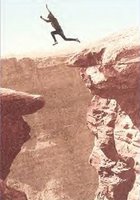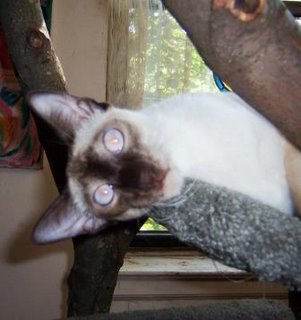From The Archives: The Edge & Waiting
[Originally posted 15 July 2006] -- From the text of The Risen.
Is an immense world of delight, clos'd by your senses five?”
— William Blake, The Marriage of Heaven and Hell.
The visionary Blake wrote a great deal about his Authentic Self’s experience in a material mind-body constrained by the reduction of five senses and by societal and institutional conventions — “the mind-forg’d manacles”. He surmised that having but two or three senses would not give us the ability to deduce anything more beyond them, and so it would be with but five. He lived in the knowledge that imagination flies free above the senses, and is the actual “image of God” in which we are made. That is, that God is imagination — imagination being the act of imaging. Imagination is not present to the five senses, which are mind-body components that filter incoming evidence of greater Reality. As we have seen, the ego-mind makes all the decisions for our embodied Authentic Self about what is acceptable as Real or not. The simulate self has emerged out of this decision-making process. Because the simulate self is manifested from the ego-mind, its experiences, and therefore its choices about the Universe, are not Authentic—that is, Real — but simulated.
 The Edge
The Edge“The edge” is the perimeter of one’s limited experience within one’s unlimited personal, potential Universe. The ego-mind, which has access to the physical senses but lacks imagination, utilizes the restrictive five senses, directed through anxiety and fear, to reduce experience. The resulting limitation is a “sphere of experience” that surrounds each individualized mind-body, which lacks conscious awareness of the Authentic Self. This imposed and limited experiential sphere is the kingdom of the simulate self and ruled by the ego-mind.
The ego-mind will allow for a kind of permeability of the edge if it fits its agenda. Individualized mind-bodies can join one another and develop a group sphere of experience, attracted by like vibration and held together by like beliefs, as dictated by the ego-mind. A group can be small, or serve as a larger container of several small groups, such as tribes, organizations, corporations, and nations. The spheres of many ego-minds often interpenetrate one another. Intergenerational transmission of beliefs is also highly likely, as parents, in total unawareness, pass on belief systems to their children, sometimes for centuries. Institutions of the simulate self, such as the government and churches, also transmit and strengthen the barriers to unlimited experience.
The edge of the sphere of experience is seldom visited by its inhabitant. There is usually no awareness of its existence. This edge can be seen in the concept of the flat earth, which successfully kept people from exploring their physical environment for fear of falling off into an abyss of unknown territory. Even though it has since been realized that the earth is not flat, the fear-generated concept that was developed by the ego-mind still actively exists in the ego-mind collective. Although we can now venture around the material globe, most of us are still encased in our invisible, protective sphere of ego-mentality, the simulate self.
The ego-mind maintains the structure of its kingdom through beliefs engendered by lies. The edge or border of its kingdom is held in place by a force field of anxiety, rather like an electrified fence. Should one move close to this edge, alarms go off and trigger the feeling of anxiety. One of the ego-mind’s lies is that the anxiety is unlimited beyond the perimeter, and once the edge is crossed, the anxiety will go on forever. Because we yield to the ego-mind’s relentless suggestions that anxiety should be avoided, we avoid the edge. Unlimited, authentic living is effectively pinched off into a limited, simulated experience. This experiential avoidance results in a “less-than” experience for the Authentic Self.
The nature of the manifested material Universe is change, which enables individualized manifestations of Authentic Self to move about in it, from one place of experience to another. Transformation of vibration cannot take place without this movement. Inherent in the design of humankind are ever-arising stimuli, causing individuals to move about in order to change form in some way, to transform. These stimuli which reveal Original Source’s aspiration for novelty,(1) are equally inherent in and activated and detected by our senses, i.e., if we didn’t have senses, we wouldn’t be stimulated to transform. All physical and non-physical senses are affected in this way.
What lies beyond this edge? Everything — different relationships, careers, whatever has potential to change. Potential living and potential dimensions are already there to be explored. As a natural course, then, one is going to be brought up against one’s edge as an effect of the Authentic Self’s directive to transform. One begins to feel suffocated in a relationship, or by a career, or by the current lifestyle. The edge is there as an interference or barrier to movement, a result of the simulate self’s need to control. The ego-mind uses anxiety and fear to keep an individuated Authentic Self from moving beyond the edge, and hence, from transforming. At best, the ego-mind drives our mind-body vehicle around and around the perimeter of our experiential sphere. Unable to tolerate this after a certain amount of time, we are “driven crazy.” As a result, the Authentic Self is unable to inherit its Divine Realm as infinitely bestowed by Original Source, and instead, endures a frozen hell of restrictive movement, masterminded and ruled by the simulate self. It can be seen that this restricted movement, as directed by the ego-mind, is also a limited attempt to simulate Original Source.
Waiting

“Watch (keep awake) therefore, for you know neither the day nor the hour.”
— Matthew 25:13
Being future-oriented, the simulate self cannot wait. Instant gratification is its motivation. Addiction of some kind —mild to wild — is a possible, if not an inevitable consequence. The ego-mind can simulate waiting in the form of patience, which is a form of control meant to endure hardship, difficulty, or inconvenience without complaint. This takes self-control and the ability to tolerate delay.
Waiting is inherent in the nature of Authentic Self, and is not meant here as patience. Being present-oriented, the Authentic Self has no need for patience, and instead it resides in resting in the feeling experience of Its Self. For the Authentic Self, waiting is rest, which it finds in its connection to Original Source, which is always at rest. For the simulate self, which uses thoughts to generate a simulation of experience, waiting is unthinkable, as well as unimaginable. Imagination belongs to Authentic Self.
The Authentic Self can imagine experiences that appear to call for endurance, if It so desires. However, it is the nature of Authentic Self to enjoy, rather than endure an experience. “Enjoy” is not meant here as the ego-mind’s concept of getting joy out of something. Rather, the ability to put joy into something — to en-joy — is what Authentic Self brings to the table of experience. To enjoy is to give. To rest or reside in the feeling of authentic enjoyment is Authentic Self’s motivation. Joy is a word for that which gives life, or Original Source, which is never-ending and unceasingly pours into our universe through the channel of Authentic Self. When joy is withheld, the feeling of life is withdrawn. Depression settles in and the gradual cessation of a material existence follows.
When Authentic Self becomes consciously aware of anxiety, it has found the edge of the simulate self’s sphere of existence.(2)
If Authentic Self is in the driver’s seat, it can choose to pull over and stop, make observations and possibly choices about what it sees as an opportunity for change, not as a barrier against an assumed danger. On some level, we all know what it’s like to come up against our life’s edges. For those who have been endeavoring in some way to raise and promote spiritual consciousness, there may be the additional experience of not being able to turn around and go back when once up against the edge. This has been described as being on the edge of a cliff, or a dark abyss, or a cloud of unknowing.
This is where waiting, or resting in the feeling of Authentic Self, comes in. When the feeling of Authentic Self arises, one also knows that one has simultaneously reached the feeling of one’s Original Source, for they are equalized as one and the same by Original Source. This equalization is love.
The simulate self will avoid the edge of the cliff. The Authentic Self, having awakened to the truth of its immortal existence and the falsehood of death, will be able to contain anxiety while resting in mental stillness at the edge, and even bring joy to the experience. It may choose to rest as long as it wants, or It may decide to examine the belief system generating the barrier. It makes this examination by focusing its full, attentive awareness upon the belief system. Under Its quiet gaze — “quiet” meaning without the ego-mind’s critical chatter — the belief system will be revealed as a lie, and then fade back into the nothingness from whence it came. The barrier has dissolved, and Authentic Self, as an individuated mind-body, can then move in the direction it chooses.
 The Authentic Self may also decide not to move or to jump off the cliff. Having reached an awareness of Its wings of immortality, fear no longer prevents or accompanies its choices. Whatever happens, there will be unlimited opportunity for Authentic Self to bring forth joy as a companion to the ever-present serenity of Original Source.
The Authentic Self may also decide not to move or to jump off the cliff. Having reached an awareness of Its wings of immortality, fear no longer prevents or accompanies its choices. Whatever happens, there will be unlimited opportunity for Authentic Self to bring forth joy as a companion to the ever-present serenity of Original Source.____________________________________
(1) “Novelty” here is meant as newness, freshness, innovation.
(2) Authentic Self-awareness is vastly different from the simulate self’s self-conscious.


